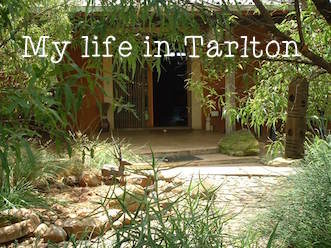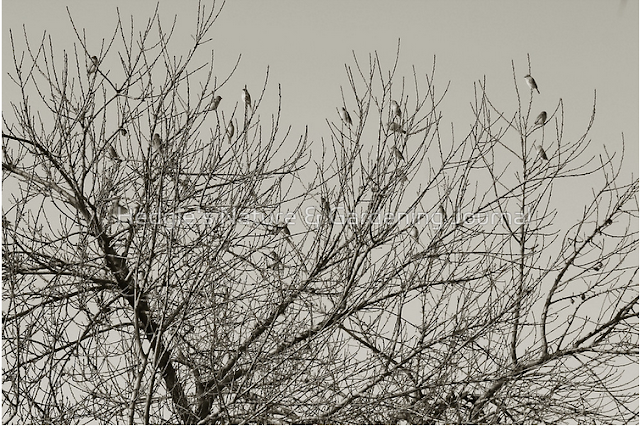I sit and drink tea in the mornings, and come out at dusk to listen as the world tucks itself in for the night…
Winding down for the day, birds in the peach tree in my garden. Dusk is when Nature is most at rest with herself.
💛 In summer I always enjoy an early-evening walk on our smallholding. No need to get in my car to find nature, I have 8.5ha right here to explore, hoping to see the Barn Owl or some Guinea fowl, but always enjoying the Bluegum trees and beautiful grasses and wild flowers along the way.
Wednesday 18 January 2017
Sunday 8 January 2017
Farm talk - Surrounded by Karee's
The front entrance of my home, densely framed by two species of Karee’s – Karee viminalis (White Karee) and Karee lancea (black Karee) and various indigenous grasses and aloes.
I am not ostentatious by nature and prefer the simple and natural things in life. Hope you enjoy and find this series interesting! I know I just LOVE to see other people’s living spaces, be it small or large, simple or ornate, in suburbia or the country, in a basement or a sky-scraper, inland or at the coast.
A garden ornament hanging from a Karee Viminalis (White Karee), and Jacko sitting at the front door
An old (and now rusty!) paraffin lamp provides some light at night. On the corner of the pathway is a clump of Restio (Cape Reed grass) and right at the back is planted some Zebra Grass (Miscanthus). Grown in India, Australia and Madagascar, South Africa and other warmer countries in Europe.
The Zebra Grass gets these beautiful white plumes at the onset of winter before dying down.
One of the many bird baths in my garden. An old log is being cleaned up by some termites (I’ve been chasing them all over the garden by pouring Diesel down their holes and this is the latest spot they’ve surfaced!)
My vantage point on the patio from where I survey the birds and my garden. A concrete-relief gecko adorns the patio wall.
Rhamnus prinoides (Dogwood or Shiny Leaf) front right of the pic – (Afrikaans) : blinkblaar, hondepishout) – a tall, conspicuous evergreen shrub, or small tree – a root decoction has been used to treat pneumonia, and the leaves used as a liniment for sprains. Parts of the plant are also reputed to have protective powers against lightning and evil spirits. It’s a rather scrambly plant and seems to be taking over this section of the garden. Planted it in the wrong spot ...
My Acacia karroo (Soetdoring) in the foreground – I just LOVE this Acacia’s beautiful thorns and little yellow pom-pom flowers. It also provides shelter and safe nesting spots for the Red Bishop and Masked Weaver (but not for the Lone Ranger! lol!)
A large metal Gecko adorns the wall of the garages
The chicken coop next to the garages where Artemis and the girls spend their nights. During the day they terrorise my garden!
The lawned driveway leading to the garages
The fenced area of my wildlife pond where Torti, my Leopard Tortoise, lives
A vintage metal plant stand on my patio housing some of my succulents
::
.
Friday 6 January 2017
An early morning storm
Every morning at 5.15am the sun rises over the bluegum bush at the back of our property, bathing the whole smallholding in golden sunlight.
This morning it was a bit late because of heavy, black cloud cover, but at 5.30am the miracle happened!
Twenty minutes later we had a quick shower and out came the sun again!
All Solly's chooks surfaced from their hiding places (they're up-and-about before 5am every morning, but the crowing starts at about 3.30am!) and here they're enjoying some mixed fowl food I put out for them.
Wednesday 4 January 2017
For the love of English Ivy
The rugged trees are mingling
Their flowery sprays in love;
The ivy climbs the laurel
To clasp the boughs above.
Author: William Cullen Bryant
Hedera helix 'Hibernica', common ivy
I've always loved having Ivy in my garden, there's nothing like Hedera helix to quickly fill an empty spot or cover a fallen-down tree. I had a couple of patches of English Ivy in my previous garden (just 1.6km from where I live now) and, as this species is very invasive and if not kept in check, can take over the whole garden, I do not have any in my current garden.
Hedera helix Ivy climbing up a wall with no support except its own suckers
I had a gorgeous hedera helix climbing up my wall between my two kitchen windows and which was home to a pair of Wagtails. Opposite this was a dead tree totally covered in ivy and which was home to a pair of Robins. The close proximity of these two nests caused endless war between the Robins and the Wagtails, with the robins always coming out tops as the Wagtails are timid and shy birds. I used to hear the noise and screeching as the Robins terrorised the Wagtails from the kitchen, and rushing out to break up the raucous.
The dead tree covered in the ivy eventually toppled under the weight, leaving the Robins homeless, after which they, thankfully, moved to another part of the garden, leaving the Wagtails in peace.
A snippet of Ivy I planted in a pot
It is said that Ivy is the goddess who carries life through the winter. Holly was her god. Ivy was in high esteem among the ancients and its leaves formed the poet's crown. It was dedicated to the Roman god Bacchus, the God of Intoxication who is often depicted wearing a wreath of ivy and grapevines. He is also depicted holding a chalice and carrying a wand which was entwined with ivy and vine leaves. Wearing a wreath of ivy leaves around the brow is supposed to prevent intoxication.
Ivy has been regarded as the emblem of fidelity and Greek priests would present a wreath of ivy to newly married persons. Women carried ivy to aid fertility and bring good luck. They also carried it to ensure fidelity and from this came the custom of brides carrying ivy.
The custom of decorating houses and churches with ivy at Christmas is sometimes seen as the Christian Church adopting pagan associations.
Common English Ivy
Botanical name
Hedera helix
Poisonous parts
Leaves
Poisonous component
didehydrofalcarinol, falcarinol, hederasaponins
This vine is grown both as an indoor and outdoor ornamental and it has caused poisoning in cattle, dogs, sheep, and humans. Symptoms of ingestion are difficulty in breathing, convulsions, vomiting, paralysis and coma.
Some Ivy in my previous garden
Dermatitis is rare but can be severe with weeping blisters which respond slowly to treatment. The berries are bitter so it's unlikely children will consume them in large quantities.
Hedera helix originates from Europe and in it's native habitat it is an important food source for a large number of insects and birds. English ivy is very popular as ornamental plant but this ivy is extremely invasive and is considered noxious in parts of the world where it has escaped into the wild. Ivy can become so dense as to exclude other native species creating ivy "deserts", even becoming so heavy as to topple trees - something which does not occur in its native habitat.
Sunday 1 January 2017
Happy New Year!
2016 has been a year full of joys, blessings, surprises, heartaches, love, some successes and a few failures, but mostly it has been a year full of gratitude. Gratitude for the good rains we've had, gratitude for the birds in my garden and gratitude that I've managed another year of good health.
And now I welcome the New Year. May your 2017 be full of new things that have never been, a year full of colours, flowers, laughter and fresh new ideas!
::
Subscribe to:
Posts (Atom)





















